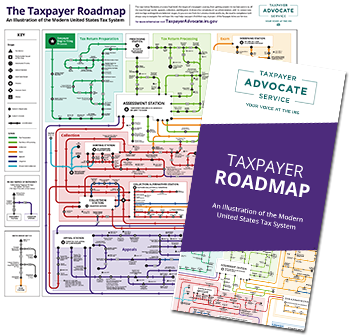Notice CP16,
Overpayment with Offset
View our interactive tax map to see where you are in the tax process. It could help you navigate your way through the IRS.
View our interactive tax map to see where you are in the tax process. It could help you navigate your way through the IRS.

Your tax return may show you’re due a refund from the IRS. However, if you owe a federal tax debt from a prior tax year, or a debt to another federal agency, or certain debts under state law, the IRS may keep (offset) some or all your tax refund to pay your debt.
This notice or letter may include additional topics that have not yet been covered here. Please check back frequently for updates.
Your tax return may show you’re due a refund from the IRS. However, if you owe a federal tax debt from a prior tax year, or a debt to another federal agency, or certain debts under state law, the IRS may keep (offset) some or all your tax refund to pay your debt.
• Past-due federal tax
• State income tax
• State unemployment compensation debts
• Child support
• Federal nontax debt, like student loans
The IRS makes offsets for past due federal taxes. All other offsets are handled by the Treasury Department’s Bureau of the Fiscal Service (BFS), previously known as the Financial Management Service (FMS). For offsets to past-due federal tax, you’ll get an IRS notice. For all other offsets, the notice will come from BFS.
You have a balance on your tax account or the IRS records show you owe other debts that must be paid before you are eligible for a refund, so the IRS has sent you a notice to tell you they applied all or part of your refund to pay them.
The first thing to do is to check the return address to be sure it’s from the Internal Revenue Service and not another agency.
If it’s from the IRS and if the offset paid a federal tax debt
If it’s not from the IRS and the offset paid something other than a federal tax debt
If you didn’t get a notice about an offset but your tax refund is smaller than you expected, call the IRS toll-free at 1-800-829-1040 (or TTY/TDD 1-800-829-4059).
If you filed a joint tax return, you may be entitled to part or all the refund offset if you are not responsible for the debt because the debt belongs solely to your spouse. To request your part of the tax refund, file IRS Form 8379, Injured Spouse Allocation.
If your tax refund was offset to pay a joint federal tax debt and you believe only your spouse or former spouse should be held responsible for all or part of the balance due, you should request relief from the liability.
If you can’t pay the remaining amount due, you need to figure out what payment options might work for your situation, and contact the IRS to set up a payment plan or discuss other way to address your balance.
Being proactive in addressing the tax debt may prevent additional penalty and interest charges and eliminate the need for the IRS to take any further action to collect the balance. For specifics, see I got a notice from the IRS on TAS Get Help and Revocation or Denial of Passport in Case of Certain Unpaid Taxes for further information.
You can go to www.irs.gov, call the IRS tax law phone line, (800-829-1040), or use the IRS forms and publications.

IRS.gov has resources
IRS.gov has resources for understanding your notice or letter.
Get Help topics
Browse common tax issues and situations at TAS Get Help
If you still need help
The Taxpayer Advocate Service is an independent organization within the IRS that helps taxpayers and protects taxpayers’ rights. We can offer you help if your tax problem is causing a financial difficulty, you’ve tried and been unable to resolve your issue with the IRS, or you believe an IRS system, process, or procedure just isn’t working as it should. If you qualify for our assistance, which is always free, we will do everything possible to help you.
Visit dev.taxpayeradvocate.irs.gov or call ![]() 1-877-777-4778.
1-877-777-4778.
Low Income Taxpayer Clinics (LITCs) are independent from the IRS and TAS. LITCs represent individuals whose income is below a certain level and who need to resolve tax problems with the IRS. LITCs can represent taxpayers in audits, appeals, and tax collection disputes before the IRS and in court. In addition, LITCs can provide information about taxpayer rights and responsibilities in different languages for individuals who speak English as a second language. Services are offered for free or a small fee. For more information or to find an LITC near you, see the LITC page on the TAS website or Publication 4134, Low Income Taxpayer Clinic List.
Refund from Another Year Applied to Debt